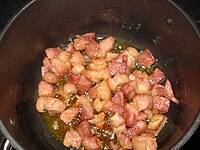Macedonian cuisine (Greek : Μακεδονική κουζίνα )[1] [2] [3] [4] [5] cuisine of the region of Macedonia , Greece . Contemporary Greek Macedonian cooking shares much with general Greek , wider Balkan and Mediterranean cuisine, including dishes from the Ottoman past. Specific influences include dishes of the Anatolian Greek , Aromanian and Megleno-Romanian , Slavic , Armenian and Sephardi Jewish population.[6] [7] Macedonian salad .
History
Buffalos breeding in Lake Kerkini A continuation from the ancient period are dishes such as lamb cooked with quince or various vegetables and fruits, goat boiled or fried in olive oil : modern recipes from Kavala to Kastoria and Kozani offer lamb with quince, pork with celery or leeks .
The arrival of Greek refugees from Asia Minor and Constantinople in the early 20th century brought also Anatolian and Constantinopolitan elements in the cuisine of the region.[8] [9] [10]
Some current specialties are trahanas with crackling, filo -based pies (cheese, leek, spinach) and meat plates (such as pork, wild boar and buffalo ). Others are tyrokafteri soupies krasates cuttlefishes in wine).
Unlike Athens , the traditional pita bread for the popular souvlaki usually is not grilled, but rather fried (information included from Greek Gastronomy Greek National Tourism Organization (GNTO) , 2004).[11] [12] [13] [14] [15] buffalo meat. There is breeding especially around Lake Kerkini . List of the Greece’s PDO (Protected Designation of Origin) certified and PGI (Protected Geographical Indication) certified products[16] [3] Ministry of Rural Development and Food .
Local products
Manouri Anevato creamy cheese Selected local products are:[17] [18] [19]
Kavourmas Pastourmas Kiwi of Pieria [16] Apple of Kastoria Peach of Naoussa [16] Krokos Kozanis saffron )Potato of Kato Nevrokopi Crispy cherries of Rodochori [16] Olive oil of Thasos Green olives of Chalkidiki [20] Throumba olives of Thasos [20] Agourelaio olive oil of Chalkidiki [20] Beams Gigantes-Elefantes of Prespa Beams Gigantes-Elefantes of Kastoria Beams Plake Megalosperma of Prespa Beams Gigantes-Elefantes of Kato Nevrokopi Beams Kina Messosperma of Kato Nevrokopi Lagana [21] Koulouri Thessalonikis simit ).[22] [23] [24] [25] Pinakoti Mount Athos in Chalkidiki.[26] Mussels Makrygialos, Pieria .[27] [28] [29] [30] [31] [32] [33] Mushrooms Grevena region.[34] [35] Petroto [36] Chalkidiki Anevato [de ; es ; la ] [36] Grevena , Kozani Kefalograviera [36] Florina , Grevena , Kastoria , Kozani Mpatzos [36] Chalkidiki , Florina , Grevena , Imathia , Kastoria , Kilkis , Kozani , Pella , Thessaloniki Manouri [37] Pieria , ThessalonikiFeta Serres , ThessalonikiKasseri
Specialties
Pork with celery Tiganiá Petoura with tomato sauce Selected main courses :[19] [65] [66]
Arni me kydonia [67] [68] Arni me spanachi [69] Kavala )Arni Κapamas [70] [71] Agriogourouno [72] [73] Cod with wild greens[74] Traditional couscous [75] Hirino me selino [76] [77] Dolmades Euriste [78] pasta ) from Pontic Greek cuisine Fasoulotavas [79] [80] [81] gigantes plaki Grivadi (kyprinos) with spinach[82] İmam bayıldı [83] Leeks and rice with sour plums [84] Lentils with bulgur [85] Louvidia with plivrimes [86] Mantza [87] [88] [89] [90] Makálo Kastoria ).[91] [92] [93] Makaronia with eggplant sauce[94] Makedonian Tsompleki[95] [96] Manitarosoupa [97] [98] Melintzanofai [99] Misoúra [100] Moussaka [101] Mussels with saffron [102] [103] [104] Ospriada Makedoniki [105] [106] [107] legumes Patsas [108] [109] Petoura petila [110] hilopites Sardines with cabbage from Pieria [111] Spanakorizo [112] Pontic Magiritsa [113] Soupies krasates [114] [115] cuttlefishes in wineSouvla Souvlaki [116] Kontosouvli [117] Tas kebab [118] [119] Tigania [120] [121] Trahanas [122] Tsigerosarmades [123] [124] Yaprákia [125] [126] Christmas food in the region of Kozani , meat and rice in pickled cabbage-leaf (a variation of sarma )Various dishes with buffalo meat
Various fish plates, especially pestrofa grivadi (kyprinos) [127] [128] [129] [130]
Various types of loukaniko [131] 











